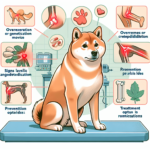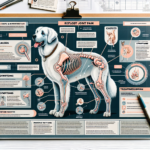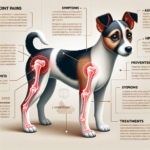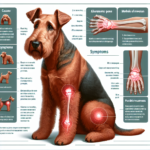Shiba Inu Joint Pain: Causes, Symptoms, Prevention, and Treatment

Introduction
The Shiba Inu is a small to medium-sized breed of dog that originated in Japan. Known for their spirited personality, fox-like appearance, and agile movements, Shiba Inus have a rich history dating back to ancient times. Initially bred for hunting small game, these dogs are now popular as companion animals due to their loyalty, intelligence, and independent nature.
While Shiba Inus are generally healthy dogs, they are not immune to certain health issues. Common concerns include allergies, eye problems, and joint-related issues. Joint pain, in particular, can significantly impact a Shiba Inu’s quality of life, making it crucial for owners to understand the causes, symptoms, prevention, and treatment options available.
Joint health is especially important for Shiba Inus because their active and agile nature puts them at risk for joint stress and related problems. Ensuring good joint health can help maintain their mobility and overall well-being as they age.
Breed-Specific Joint Pain Risks
Genetic Predisposition
Shiba Inus, like many other breeds, have a genetic predisposition to certain joint-related issues. Hip dysplasia, a condition where the hip joint doesn’t fit properly into the hip socket, is one such concern. This can lead to arthritis and chronic pain over time. Elbow dysplasia, another genetic condition, affects the elbow joint and can also result in long-term discomfort and mobility issues.
Age-Related Risks
As Shiba Inus age, the risk of developing joint pain increases. Arthritis is a common age-related condition that affects the joints, causing inflammation, pain, and stiffness. For Shiba Inus, signs of joint pain may start to appear as early as middle age, around 6-8 years old. It’s essential to monitor their joint health closely as they age to catch any issues early.
Activity Level and Joint Stress
Shiba Inus are known for their high energy levels and love for physical activity. While regular exercise is beneficial for their overall health, excessive or high-impact activities can put stress on their joints. Activities like jumping, running on hard surfaces, or intense play sessions can contribute to joint wear and tear over time.
Common Symptoms of Joint Pain in Shiba Inus
General Symptoms
- Limping or favoring one leg
- Stiffness, especially after rest or sleep
- Reluctance to move, jump, or climb stairs
- Decreased activity level or interest in play
- Visible discomfort or pain when touched
- Swelling around the joints
Breed-Specific Symptoms
In Shiba Inus, joint pain may manifest in specific ways due to their unique build and behavior. Owners might notice a change in their gait, such as a “bunny hop” when running, or a reluctance to engage in activities they previously enjoyed. Additionally, Shiba Inus may become more irritable or withdrawn if they are experiencing chronic pain.
When to Consult a Vet
If you observe any of the above symptoms in your Shiba Inu, it’s essential to consult a veterinarian promptly. Early diagnosis and intervention can help manage joint pain more effectively and improve your dog’s quality of life. Regular veterinary check-ups are also crucial for monitoring joint health and catching any issues early.
Preventive Measures for Joint Health
Exercise Recommendations
Regular, moderate exercise is key to maintaining joint health in Shiba Inus. Activities like walking, swimming, and gentle play are excellent options. Avoid high-impact exercises like jumping or running on hard surfaces, as these can exacerbate joint stress. Aim for consistent, low-impact activities that keep your Shiba Inu active without overloading their joints.
Dietary Suggestions
A balanced diet rich in essential nutrients can support joint health. Look for dog foods that contain glucosamine and chondroitin, which help maintain cartilage health. Omega-3 fatty acids, found in fish oil supplements, can also reduce inflammation and support joint function. Always consult your veterinarian before adding supplements to your dog’s diet.
Weight Management
Maintaining a healthy weight is crucial for reducing joint stress. Excess weight puts additional pressure on the joints, exacerbating pain and discomfort. Monitor your Shiba Inu’s weight closely and adjust their diet and exercise routine as needed to keep them at an optimal weight.
Early Screening and Monitoring
Regular veterinary check-ups are essential for early detection of joint issues. Your vet may recommend specific screening tests, such as X-rays or joint fluid analysis, to assess joint health. Early intervention can help manage joint pain more effectively and prevent further deterioration.
Treatment Options for Joint Pain
Non-Surgical Treatments
Non-surgical treatments for joint pain in Shiba Inus include medications, physical therapy, and lifestyle adjustments. Anti-inflammatory medications and pain relievers can help manage symptoms, while physical therapy can improve joint function and mobility. Lifestyle adjustments, such as providing a comfortable bed and avoiding high-impact activities, can also alleviate joint stress.
Surgical Options
In severe cases, surgical intervention may be necessary. Common surgical options for joint pain include hip replacement, arthroscopy, and joint fusion. These procedures can help alleviate pain and improve mobility, but they come with risks and require a significant recovery period. Consult your veterinarian to determine the best course of action for your Shiba Inu.
Alternative Therapies
Alternative treatments like acupuncture, hydrotherapy, and massage can also benefit Shiba Inus with joint pain. Acupuncture can help reduce pain and inflammation, while hydrotherapy provides low-impact exercise that supports joint health. Massage can improve circulation and alleviate muscle tension around the joints.
Lifestyle and Management Tips
Daily Care Routine
A consistent daily care routine can help manage joint pain in Shiba Inus. This might include gentle exercise, a balanced diet, and regular veterinary check-ups. Providing a comfortable bed and avoiding high-impact activities are also essential components of a joint-friendly routine.
Modifying the Home Environment
Making your home more comfortable for a dog with joint pain can significantly improve their quality of life. Consider adding ramps to help them navigate stairs, providing orthopedic beds for better support, and using non-slip mats to prevent falls. These modifications can reduce joint stress and make daily activities easier for your Shiba Inu.
Long-Term Management
Long-term management of joint pain involves a combination of regular veterinary care, appropriate exercise, a balanced diet, and lifestyle adjustments. Consistent monitoring and early intervention can help keep your Shiba Inu active and happy despite joint pain. Work closely with your veterinarian to develop a comprehensive management plan tailored to your dog’s needs.
FAQs About Shiba Inus and Joint Pain
What are the early signs of joint pain in Shiba Inus?
Early signs of joint pain in Shiba Inus include limping, stiffness, reluctance to move, and decreased activity levels. If you notice any of these symptoms, consult your veterinarian for a thorough evaluation.
Can joint pain in Shiba Inus be prevented?
While genetic predispositions cannot be entirely prevented, maintaining a healthy weight, providing regular low-impact exercise, and ensuring a balanced diet can help reduce the risk of joint pain. Early screening and monitoring are also crucial for catching issues early.
Are there specific exercises that are better for Shiba Inus with joint pain?
Yes, low-impact exercises like walking, swimming, and gentle play are ideal for Shiba Inus with joint pain. Avoid high-impact activities like jumping or running on hard surfaces, as these can exacerbate joint stress.
What dietary supplements can support joint health in Shiba Inus?
Supplements containing glucosamine, chondroitin, and omega-3 fatty acids can support joint health. Always consult your veterinarian before adding supplements to your dog’s diet to ensure they are appropriate and safe.
When should I consider surgical options for my Shiba Inu’s joint pain?
Surgical options should be considered when non-surgical treatments are no longer effective, and your dog is experiencing severe pain or mobility issues. Consult your veterinarian to determine the best course of action based on your dog’s specific condition.
Conclusion
Joint pain is a significant concern for Shiba Inus, but with proper understanding and proactive measures, it can be managed effectively. By recognizing the causes and symptoms of joint pain, taking preventive steps, and exploring various treatment options, you can help ensure your Shiba Inu remains active and comfortable throughout their life. Regular veterinary check-ups and a comprehensive care plan tailored to your dog’s needs are essential for maintaining their joint health and overall well-being.




